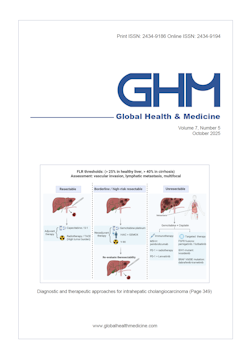Global Health & Medicine 2024;6(4):236-243.
Effects of low-frequency ultrasound combined with microbubbles on breast cancer xenografts in nude mice
Peng XL, Li LS, Liu YC, Guo YQ, Pang Y, Ding SN, Zhou J, Wang L, Chen L
The aim of this study was to explore the effects of low-frequency ultrasound (US) combined with microbubbles (MBs) on breast cancer xenografts and explain its underlying mechanisms. A total of 20 xenografted nude mice were randomly divided into four groups: a group treated with US plus MBs (the US + MBs group), a group treated with US alone (the US group), a group treated with MBs alone (the MBs group), and a control group. In different groups, mice were treated with different US and injection regimens on an alternate day, three times in total. Histological changes, apoptosis of cells, microvascular changes, and the apoptosis index (AI) and microvascular density (MVD) of the breast cancer xenograft were analyzed after the mice were sacrificed. Results indicated that the tumor volume in the US + MBs group was smaller than that in the other three groups (p < 0.001 for all). The rate of tumor growth inhibition in the US + MBs group was significantly higher than that in the US and MBs groups (p < 0.001 for both). There were no significant differences in histological changes among the four groups. However, the AI was higher in the US + MBs group than that in the other three groups while the MVD was lower (p < 0.001 for all). All in all, low-frequency US combined with MBs can effectively slow down the growth of breast cancer in nude mice. In summary, low-frequency US combined with MBs has a significant effect on breast cancer treatment. Cavitation, thermal effects, and mechanical effects all play a vital role in the inhibition of tumor growth.
DOI: 10.35772/ghm.2024.01037







